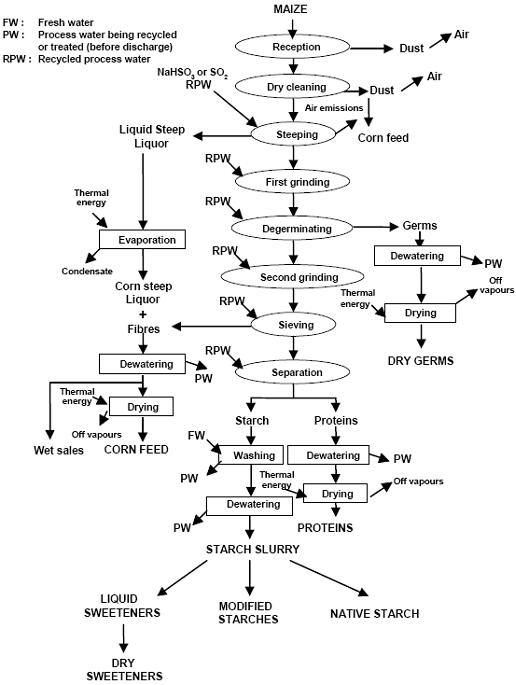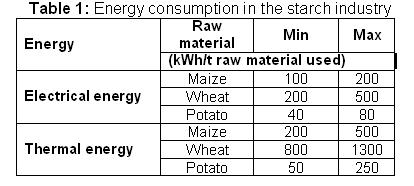Maize starch
Back to EFFICENCY FINDER OF FOOD INDUSTRY
Back to Information about starch, potatoes & grain milled production
1. GENERAL DESCRIPTION:
- 1. General Flowsheet of maize starch production
- (BAT for Food, Drink and Milk Industries, June 2005)
Figure 1: Production of maize starch. Literature: BAT in Food, Drink and Milk Industries, June 2005
- 2. Description of techniques, methods and equipment
- (BAT for Food, Drink and Milk Industries, June 2005)
The raw material is washed using aspiration and screening to remove dust, chaff, broken grain, cobs and another extraneous material. The maize is soaked in water with sulfur dioxide (SO2) or sodium bisulphite (NaHSO3), for around 36 hours, in a process known as steeping. After steeping, the maize is passed through several grinding and separation operations until only starch and gluten remain. Starch and gluten are separated, typically using centrifugal methods. This raw starch is washed with drinking water, using countercurrent flow, in a series of four to six centrifuges. At one end, raw starch is the input and process water is the output and at the other hand, refined starch is the output and fresh drinking water is the input. The starch, which at this stage is called refined starch, is then dewatered and dried.
- 3. Temperature ranges and other parameters (table)
- 4. Benchmark data
- (BAT for Food, Drink and Milk Industries, June 2005)
The energy consumption depends on the starch and starch derived products produced on the site, i.e. on the techniques and processes involved in the starch production and co-products management. However, the main use of energy in starch production is thermal energy for the evaporation and drying processes. The energy used to produce starch slurry is low in comparison to the final production of dry products. More energy is consumed at sites where evaporation and/or drying processes are used for co-products such as fibre, soluNes and proteins than at sites where solubles are landspread and fibre is sold as wet cattle feed. The general consumption of energy in the starch sector is given in the following table:
2. NEW TECHNOLOGIES:
- a) Changes in the process
- b) Changes in the energy distribution system
- c) Changes in the heat supply system
Back to EFFICENCY FINDER OF FOOD INDUSTRY
Back to Information about starch, potatoes & grain milled production

